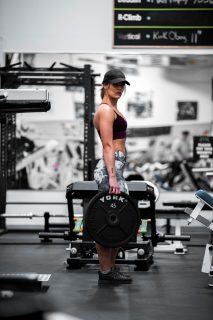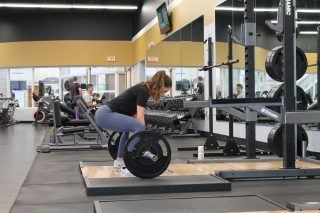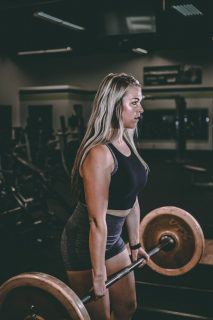Longevity LIVE Partner Content. Do you love the adrenaline rush of weightlifting, and it’s almost addictive for you? Well, lifters love weightlifting more than anything else in their lives. It gives them a sense of strength and invincibility that has no match. However, it’s not all roses; because there are some challenges.
Deadlifts, if done with a slightly poor posture and improper technique, can lead to knee pain. Knee pain is quite disheveling and disturbing, and you should know what to do if you experience it during and after deadlifts because it’s not normal to have this pain deadlifting.
If you want to know all about knee pain during deadlifts, how it happens and how to get rid of it, then this article is a treasure. Benefit from it by reading till the end.
How Do I Keep My Knees From Hurting When Lifting Weights?

Photo by Anastase Maragos on Unsplash
Deadlifting puts a tremendous amount of pressure on your knees. The knee stabilizers come into action during a deadlift with glutes, hamstrings, quads, and calves. Deadlifts’ pressure on your joints and especially knees is quite undeniable, but it’s not only harmful.
It strengthens the stabilizing muscles as they are engaged and activated during the lift. However, the wrong posture can change things for the worse; it can cause extreme knee pain.
- The most important thing to do to save the knees from lingering and debilitating knee pain is to use the right posture and correct technique for the lift. If you are constantly hurting during and after a deadlift, here are a few things to do:
- See if you are locking out your knees at the top of the lift or turning them inward while lifting. These factors can lead to knee pain because extra pressure will be put on your knee muscles, stabilizers, tendons, and ligaments, resulting in soreness and inflammation. Follow the right techniques for a comfortable experience.
- Use powerlifting knee sleeves. The compression sleeves keep the joints warm, protected, and functional.
- If conventional deadlifts are hurting your knees, you can go for sumo deadlifts. It uses the same principle of lifting, but the legs are opened wider than your arms, which takes considerable pressure off the knees.
Movement of the Knee During the Deadlift
We are considering a conventional deadlift stance here. The sumo stance is slightly different, and the knees work differently.

Photo by Danielle Cerullo on Unsplash
The conventional deadlift starts with a narrow stance: the legs are not too wide apart. Your hands are placed wider on the barbell than your legs and knee’s width. Starting the conventional deadlift, you will start pulling the barbell off the floor with straight arms until the hips, knees, and shoulders are all locked out.
At this point, the barbell will be close to your shins, focusing on the foot’s midline. The foot’s midline is an important focal point during deadlifts, and a straight line is maintained throughout the lift until the bar reaches the top position. The entire body will form one line with your knees, hips, and shins straightening out completely.
Pull the bar above your shins: flatten your knees to assist the pull and activate the quads. When you flatten your knees, quads activate and stabilize your posture. The knee will remain extended to support weight and stance.
During the bar’s descent from the high position, the knees are flexed and bent, locking outward, pressure on muscles and ligaments is released, and smooth movement is assisted.
Reasons Why Your Knee Hurt While Deadlifting
These are some of the reasons why you might have to go through knee pain while deadlifting:
1. Having an Excessively Wide Stance
A wide stance generally releases pressure on the knees, as in the sumo-style deadlifts, but the excessive widening of the legs can put extra pressure on the stabilizer muscles. That extra pressure can lead to pain and inflammation later on.
2. Your Starting Position Is Too Low

Photo by jan valle from Pexels
Bending your knees excessively and increasingly close to the floor can dishevel your knees as well. You may experience shooting pain and continuous discomfort if you are straying too low to pull up the bar. This is because the right height of the knees puts the muscles in a more stable stance, and any disruption in that stance can hurt your muscles.
3. Keeping Your Weight Too Far Ahead Of You
The bar remains close to your body during a deadlift, which remains true throughout the lift. The bar is lifted, keeping close to your body. If your barbell is too far away from your hands and body, it will disturb the muscular balance and stability, causing pain and inflammation or even hyperextension of the muscles.
4. Lifting The Bar Too Fast
A deadlift is not your agility test: believe it or not, you will never be praised for a quick lift because that’s not the objective of the deadlift. It’s all about control and power, and performing the lift too fast can hurt the joints, causing pain and discomfort.
5. Locking Your Knees Too Early Or Excessively
If you lock your knees too early or too much, you are almost bringing it on yourself. Knee locking and lockout positions are extremely important during deadlifts; because deadlifting is intense lifting, one wrong move can hinder your movement and harm your knees.
6. Not Locking Your Knees at the Top of the Deadlift

Photo by cottonbro from Pexels
Know where to lock and when to unlock your knees during a deadlift. If you are doing the wrong things at times, you will be damaging your knees. For example, if you are not locking your knees at the top position during the deadlift, the knee may flex, and that’s problematic. It can lead to pain and inflammation due to the extension of the joint.
7. Having a Rapid, Uncontrolled Descent
Just like it’s essential to control your lifts while locking the knees, it’s imperative to control your speed and knee flexion during the descent, or get ready for some serious inflammation and swelling.
8. Moving Your Knees Forward Before Starting to Put the Bar Down
This is yet another grave mistake. The bar goes past the knees, downward first, and only then are the knees pushed out/ locked out. Failing to do so can land you with knee problems, including pain.
Ways To Improve Knee Pain During Weightlifting
1. Improve Your Knee Mobility and Strength
Weightlifting is great for your joints and especially your knees if you are weightlifting. Yes, you may experience pain and swelling after deadlifts, but those symptoms owe themselves to poor posture and incorrect technique. Weightlifting strengthens your knees by strengthening the stabilizing muscles like quads, hams, glutes, and calves. So, keep on lifting, and things will get better.
2. Use Proper Form In Your Weightlifting
This golden rule helps alleviate pain and pressure from the knees. There is no rocket science involved in this business: follow proper technique and maintain the right posture: you will conquer the move without hitting or causing any knee issues.
3. Wearing Powerlifting Knee Sleeves
Wearing compression knee sleeves will help a great deal. The knee sleeves are carefully crafted pressure garments that increase blood flow from your legs towards the heart, leading to a significant decrease in pain, swelling, and stiffness in your legs and knees.
The neoprene material keeps you warm and comfortable. The medium stretch gives a snuggle that helps alleviate minor stiffness in the legs. The knee sleeves by DMOOSE are breathable and ensure a wonderful and pleasant weight lifting experience every time.
Workout knee sleeves also help you stabilize the knee joint during the intense deadlift and improve your workout with better balance.
Final Thoughts
Knees come into action during deadlifts, and while they are strengthened during these lifts, they may become swollen and cause pain. Exercise, proper weightlifting techniques, correct posture, and gym aids like workout knee sleeves will help alleviate pain and discomfort.
References
McCarthy, Ian, et al. ‘Analysis of Knee Flexion Characteristics and How They Alter with the Onset of Knee Osteoarthritis: A Case-Control Study. BMC Musculoskeletal Disorders, vol. 14, no. 1, May 2013, p. 169. BioMed Central
Who Is The Author
Lubna Yahya



![women [longevity live]](https://longevitylive.com/wp-content/uploads/2020/01/photo-of-women-walking-down-the-street-1116984-100x100.jpg)










